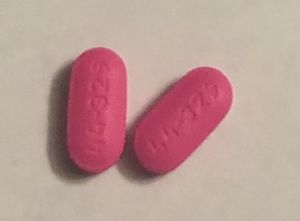Diphenhydramine: Difference between revisions
Notjusttired (talk | contribs) m (Text replacement - "url-status\=" to "url-status=") |
Notjusttired (talk | contribs) m (→Additional active ingredients: link) |
||
| Line 5: | Line 5: | ||
* [[acetaminophen]] (paracetamol) for night-time pain relief | * [[acetaminophen]] (paracetamol) for night-time pain relief | ||
* expectorants like guaifenesin, or [[Dextromethorphan|dextromethorphan hydrobromide]] in cough products<ref name=":0">{{Cite web|url=https://www.medicines.org.uk/emc/search?q=Diphenhydramine&filters=activeingredients%5B191%5D&offset=1&limit=50&orderBy=product&refreshFilters=true|title=Electronic Medicines Compendium|last=|first=|authorlink=|last2=|first2=|authorlink2=|date=|website=www.medicines.org.uk|archive-url=|archive-date=|url-status=|access-date=2021-02-13}}</ref> | * expectorants like guaifenesin, or [[Dextromethorphan|dextromethorphan hydrobromide]] in cough products<ref name=":0">{{Cite web|url=https://www.medicines.org.uk/emc/search?q=Diphenhydramine&filters=activeingredients%5B191%5D&offset=1&limit=50&orderBy=product&refreshFilters=true|title=Electronic Medicines Compendium|last=|first=|authorlink=|last2=|first2=|authorlink2=|date=|website=www.medicines.org.uk|archive-url=|archive-date=|url-status=|access-date=2021-02-13}}</ref> | ||
* levopenthol, a decongestant and [[Analgesics|pain reliever]]<ref name=":0" /><ref>{{Cite web|url=https://www.drugs.com/international/levomenthol.html|title=Levomenthol|website=Drugs.com|language=en|access-date=2021-02-13}}</ref> | * [[levopenthol]], a decongestant and [[Analgesics|pain reliever]]<ref name=":0" /><ref>{{Cite web|url=https://www.drugs.com/international/levomenthol.html|title=Levomenthol|website=Drugs.com|language=en|access-date=2021-02-13}}</ref> | ||
Other common ingredients include: | Other common ingredients include: | ||
* ethyl (a form of alcohol) especially in cough syrups | * ethyl (a form of alcohol) especially in cough syrups | ||
Revision as of 20:35, January 22, 2022
Diphenhydramine or diphenhydramine hydrochloride is a commonly used antihistamine, which is also used for coughs, to aid sleep, for certain symptoms of Parkinson's diease, as well as for allergy symptoms, bites, itching and eczema.[1][2] Diphenhydramine is the active ingredient in Benadryl, which is sometimes used as a sleep aid as well as an anti-histamine.[1]
Additional active ingredients[edit | edit source]
Products containing diphenhydramine often contain other ingredients, for example:
- acetaminophen (paracetamol) for night-time pain relief
- expectorants like guaifenesin, or dextromethorphan hydrobromide in cough products[3]
- levopenthol, a decongestant and pain reliever[3][4]
Other common ingredients include:
- ethyl (a form of alcohol) especially in cough syrups
- food colorings, especially reds and blues[3]
Brand names[edit | edit source]
Diphenhydramine is marketed under many different brand names including:
- Allermax
- Banophen
- Benadryl
- Benylin Chesty Coughs Original and Benylin Mucus Cough Nights (syrup)
- Compoz Nighttime Sleep Aid
- Covonia Nighttime Forumla
- Diphedryl or Diphenhis
- Nytol One-A-Night
- Nytol QuickCaps
- QlearQuil Nightitme Allergy Relief
- Siladryl Allergy
- Silphen Cough
- Sominex original
- Tranquil
- Twilite
- Vanamine PD
- Unisom Sleepgels maximum strength
- Z-Sleep
- ZzzQuil[1][5][6]
Theory[edit | edit source]
Evidence[edit | edit source]
Dosage[edit | edit source]
The usual dose suggested is:
- creams for bites, itches or eczema - apply a thin layer once or twice a day
- allergies and hayfever, itching or as an anti-histamine - 25mg to 25mg, 3 or 4 times a day
- cough and cold symptoms – diphenhydramine is typically mixed with other medicines, the dose depends on the medicine
- creams for bites, itches or eczema - apply a thin layer once or twice a day
- sleep problems or insomnia - 25mg to 50mg[2]
Risks and safety[edit | edit source]
Diphenhydramine has a wide range of side effects include dizziness and drowsiness.[1]
It is described as non-addictive/not habit forming, but recently concerns have been raised about long term use including the reduced effectiveness in the long term, causing people to increase the dose.[7] Theoharides and Stewart (2016) stated that in high risk over 65s taking 50mg for 3 years or 50mg for 3 years was associated with cognitive dysfunction.[7]
Using a product containing diphenhydramine marketed for nighttime pain, coughs or cold and flu also involves the side effects of other active ingredients, or from inactive ingredients such as food colorings.[3][6]
Costs and availability[edit | edit source]
Diphenhydramine is available over the counter, under many different brand names including Benadryl.[1] Diphenhydramine is available in tablet, capsule or syrup/liquid form, and in anti-histamine products as a cream, spray or ointment to be applied to the skin.[8]
In the UK, diphenhydramine is a pharmacy-only medication and is not given on prescription.[3] Diphenhydramine is available under the brand names Benylin Chesty Coughs, Histergan, and Nytol Once-A-Day.[2]
See also[edit | edit source]
Learn more[edit | edit source]
- Diphenhydramine - drugs.com
- Diphenhydramine - NHS
- Diphenhydramine - WedMD
References[edit | edit source]
- ↑ 1.0 1.1 1.2 1.3 1.4 "Diphenhydramine Uses, Dosage & Side Effects". Drugs.com. Retrieved November 9, 2020.
- ↑ 2.0 2.1 2.2 "Diphenhydramine (including Nytol Original & Histergan): drowsy antihistamine". National Health Service. September 21, 2018. Retrieved February 14, 2021.
- ↑ 3.0 3.1 3.2 3.3 3.4 "Electronic Medicines Compendium". www.medicines.org.uk. Retrieved February 13, 2021.
- ↑ "Levomenthol". Drugs.com. Retrieved February 13, 2021.
- ↑ "£8.59 - Benylin Chesty Coughs Original 300ml". Weldricks Pharmacy. Retrieved February 12, 2021.
- ↑ 6.0 6.1 "Covonia Night Time Formula - Summary of Product Characteristics (SmPC)". www.medicines.org.uk. Retrieved February 13, 2021.
- ↑ 7.0 7.1 Theoharides, TC; Stewart, JM (2016). "Antihistamine and mental status" (PDF). J Clin Psychopharmacol. 36 (3): 195–7.
- ↑ "Diphenhydramine Oral: Uses, Side Effects, Interactions, Pictures, Warnings & Dosing". www.webmd.com. Retrieved February 13, 2021.


